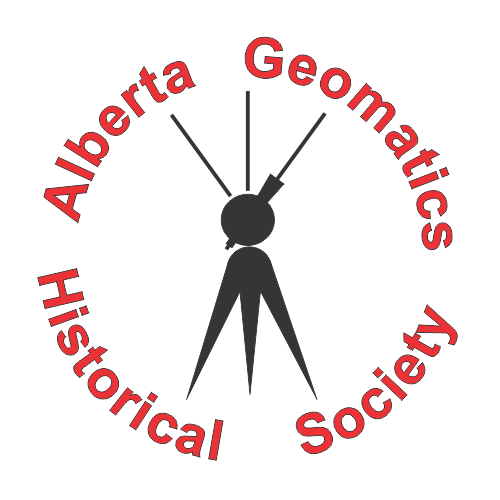
19. There were no Stories about Drafting
By Gordon Olsson
In history books about surveying, there are lots of stories involving adventure, transportation, climbing mountains, fording streams, fighting the elements and so on. It is doubtful, however, if one can find any stories about drafting survey plans. As Lou Breton, ALS (Hon. Life) once said nobody tells any stories about their time in the office. But drafting survey plans was not insignificant. It required knowledge, skill, experience and an artistic flair. It also required perseverance – imagine spending weeks drafting a survey plan several metres long on linen using basic drafting instruments such as T squares, protractors, straight edges, scale rules and pen and ink hoping a spilled bottle of ink, or a major plotting mistake would not require starting all over.
Undoubtably, over the centuries, drafting evolved, but it was not until computer plotting appeared that any real change occurred. Some technical developments such as mechanical drafting machines, lettering guides, lettering sets and electric erasers appeared in a 1931 Eugene Dietzgen Co. catalogue. However, it would be a few decades before these showed up on most land survey drafting desks. Objects representing these developments will have to wait for a future article before being illustrated.
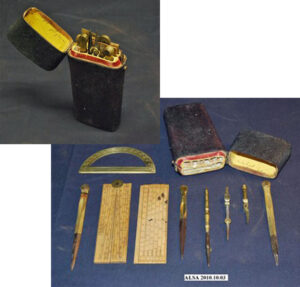
Drafting Set. This is the oldest drafting object in the ALSA Collection. The set contains a small brass protractor, two wooden scales, three dividers, one lining pen, a lining pen attachment presumably for a (missing) compass. The dividers and scales indicate it may have been used for sea navigation. Inside the case is written “Grazebrook, Springhill, Bristol” which may be the address of the original owner. A piece of newspaper placed in the case to protect the instruments is dated 1845. The drafting set was purchased from Denny DeMeyer in 2008 along with a sextant and an artificial horizon with funds donated by the Surveyors Historical Foundation (See article 1 of this series). Dennis DeMeyer, a surveyor from the state of Washington, was part of the ALSA David Thompson bicentennial brigade team that paddled from Rocky Mountain House to Fort William, Ontario in 2008.
ALSA 2010.10.03
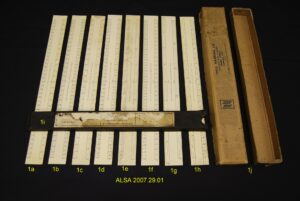
Surveyor’s set of nine cardboard scales. Each scale is a flat scale marked “Eyre and Spottiswoode (Bible Warehouse) Limited London.” Six of the scales are 10, 20, 30, 40, 50 and 60 chains to the inch respectively. The others are 1/2500, 1/500 and 6 inches to a mile. A similar set of scales made by Eyre and Spottiswoode is purported to have been made circa 1920. Eyre and Spottiswoode was a British publisher mainly of Bibles. The box containing the scales is labelled “Hall Harding Ltd.” which was a London-based manufacturer of drawing-office equipment. Scales were not to be used as a straight edge for drawing lines as it deteriorated the edge of the scale.
Donated by C.H. Weir ALS#164.
ALSA 2007.29.01
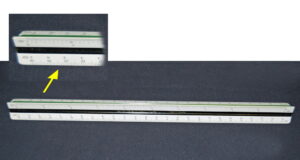
This triangular scale is an imperial scale used for plans of scales 100, 250, 500, 1000, 2500 and 5000 feet to an inch. When the metric system was adopted in Canada in the 1970s, metric scales were used. In the metric system scales were proportional, for example, 1:50, 1:100, 1:200, and so on (one unit on the plan equaled 50, 100 or 200 units on the ground). Triangular scales had advantages over flat scale. They were easier to read when measuring or laying out distances and they were more functional because one triangular scale had six scales on it. The practice of not using scales as a straight edge for drawing lines was carried over to triangular scales even when they were made of plastic.
Donated by Akram Din, Southern Alberta Land Titles Office
ALSA 2011.06.01
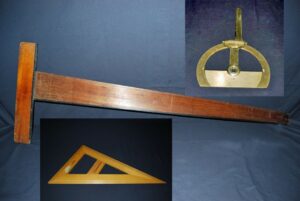
Basic objects required for drafting. The T square provided a reference line for the drawing. If the east-west axis of the drawing coincided with the arm of the T square it formed a base for laying out angles with a protractor or triangle. It was also used for horizontal guidelines for lettering in title blocks, plan legends, and so on. The 30, 60 and 90 degree triangle was used to lay out plan borders and to line up title blocks and occasionally for boundary lines. Protractors were used to plot bearings on the plan. The one at the top left corner is called an arm protractor because it could be set on the arm of the T square with the arm of the protractor being moved to the bearing of the line to be plotted.
ALSA 2008.14.19 – T square and ALSA 2008.14.11 – protractor, donated by Dave Williams, ALS (Ret.).
ALSA 2010.06.08 – triangle, donated by Steve Cherwonick, ALS#238.
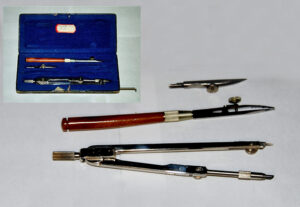
Kern Drafting Set. This set contains a couple of very basic drafting instruments – a lining pen and a compass with two attachments: one for a lead (pencil) and another for an ink pen.
Donated by C.H. Weir ALS#164.
ALSA 2007.28.04
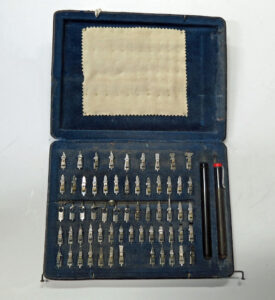
Pelican Graphic Nib Set. This pen set contains 61 pen nibs and two nib holders. It was made in Germany and was used by Ken Moyer. Ken worked as a drafter for Clark, Swanby & Associates from 1964 to 1968 when most lettering was still done by free hand. Later he worked for several other Alberta survey firms in Alberta including Wolley-Dod & McCrimmon in Calgary and Hosford, Impey & Welter in Grande Prairie.
Donated by Ken Moyer
ALSA 2016.05.07

Instruments for drawing small and large circles. On the left is a drop bow compass. It is used to draw small circles such as monument symbols. The beam compass shown on the right comes with bars which can joined together. A sliding attachment holds a pen or pencil so very large circles could be drawn. It is made by Alpha Precision Instruments, Bavaria, Germany.
ALSA 2011.06.03 – drop bow, compass donated by Akram Din, Southern Alberta Land Titles Office
ALSA 2008.14.10 – beam compass
Donated by Dave Williams, ALS (Ret.)
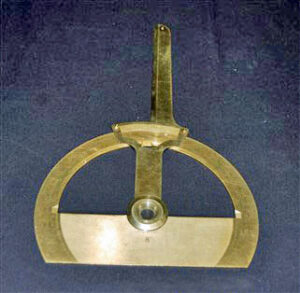
Railway Curves. This set of 12 curves were used by Brown Okamura & Associates to draft curves that transition from a straight line to a circular curve.
Donated by Dave Williams, ALS (Ret.)
ALSA 2008.14.11
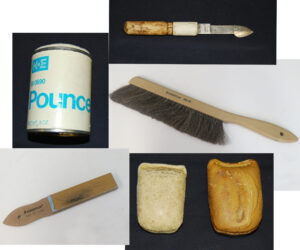
Drafting accessories. Pounce was used for better ink adherence. A note accompanying pounce in a 1921 K& E catalogue says “When cloth will not take ink readily, dust on a small quantity of the pounce and rub it in evenly with a soft fabric until the cloth has lost its excessive gloss. The pounce must be thoroughly removed before applying the ink.” The drafting knife was used to scrape off ink on linen when corrections were required. The Staedtler drafting brush was used to brush off pencil eraser debris and scrapped off ink left on the linen, The sandpaper block was used to sharpen pencils and the paper weights were used to hold the drafting linen in place on the drafting table.
ALSA 2008.14.36 – pounce, donated by Dave Williams ALS (Ret.)
ALSA 2007.22.10 – drafting knife and ALSA 2007.22.15 paper weights (bottom right corner), donated by R.M McCutcheon, ALS#139.
SHF 2018.01.23 – Staedtler drafting brush and SHF 2018.01.24 sandpaper block (bottom left corner), Ed Scovill Estate.
Sources of Information:
- 1910 E.R. Watts & Son Catalogue of Engineers’ Surveyors’ Architects’ and Draughtsman’s Instruments and Supplies, London, England.
- Catalogue of Keuffel & Esser, Canada Edition, 1913.
- Catalogue of Keuffel & Esser, 36th Edition, 1921, page 16.
- Catalog of Eugene Dietzgen Co. Drafting and Surveying, 1931, pages 225 to 257, 287.
- Elementary Surveying, Breed and Hosmer, 8thEdition, 1945.
- Website: https://reretro.wordpress.com/tag/eyre-spottiswoode-publishers-ltd-cardboard-scales/
Author: Gordon Olsson, ALS (Hon. Life)
April 1, 2022
Copyright 2024 © Alberta Geomatics Historical Society
